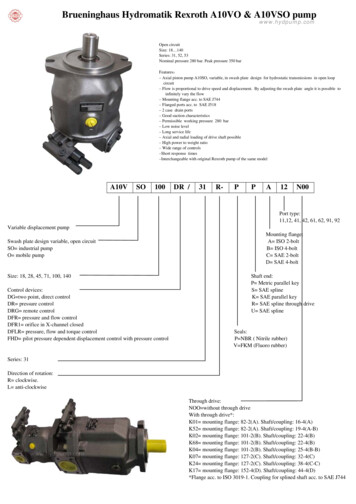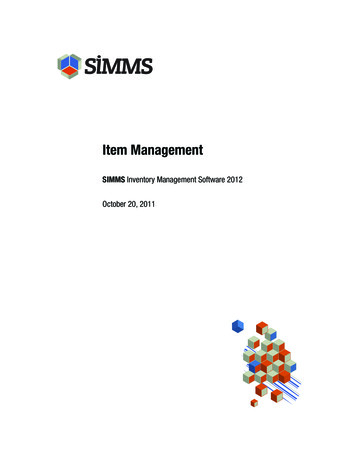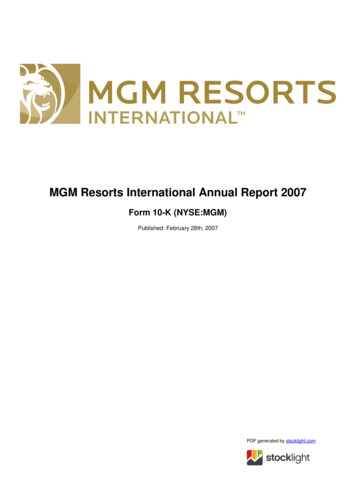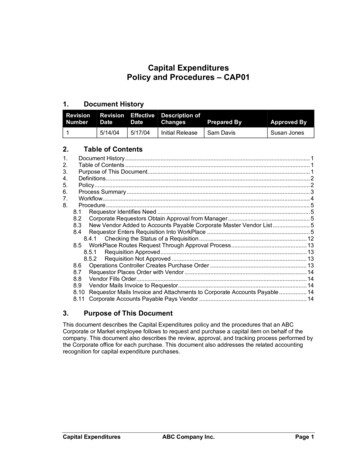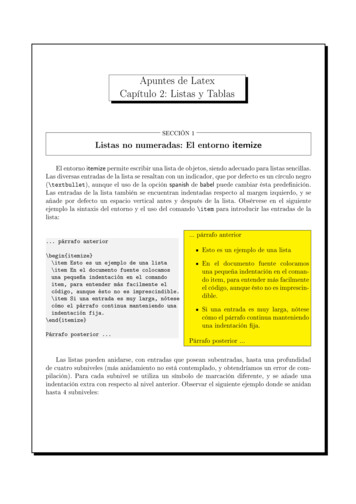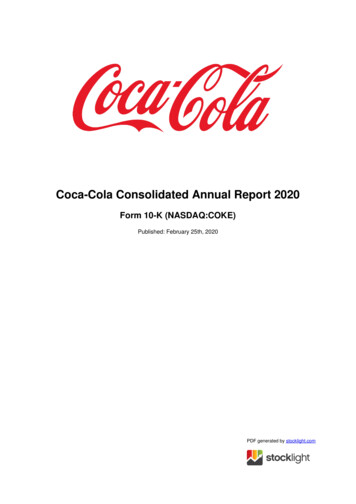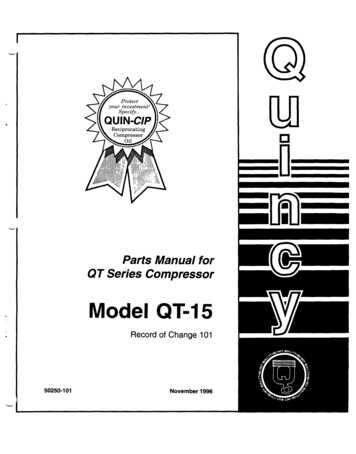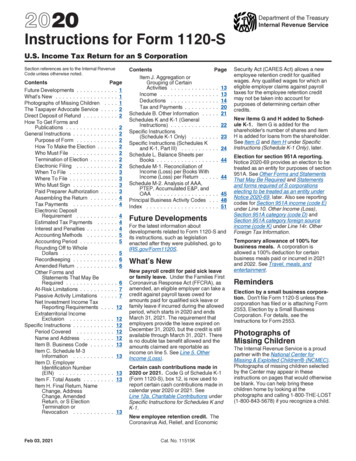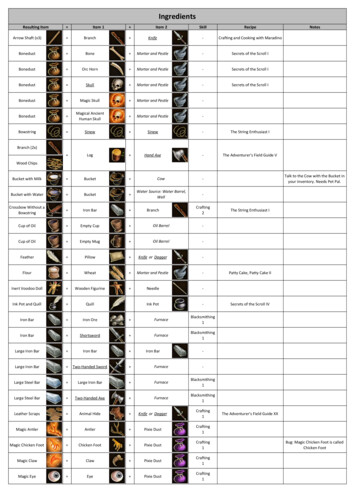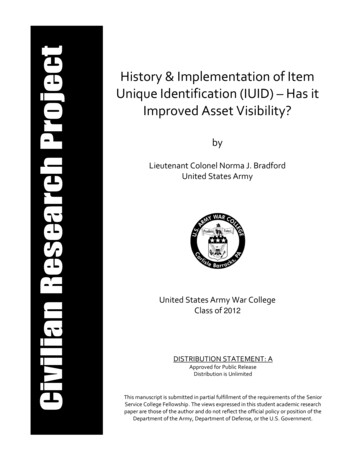
Transcription
History & Implementation of ItemUnique Identification (IUID) – Has itImproved Asset Visibility?byLieutenant Colonel Norma J. BradfordUnited States ArmyUnited States Army War CollegeClass of 2012DISTRIBUTION STATEMENT: AApproved for Public ReleaseDistribution is UnlimitedThis manuscript is submitted in partial fulfillment of the requirements of the SeniorService College Fellowship. The views expressed in this student academic researchpaper are those of the author and do not reflect the official policy or position of theDepartment of the Army, Department of Defense, or the U.S. Government.
The U.S. Army War College is accredited by the Commission on Higher Education of the Middle StatesAssociation of Colleges and Schools, 3624 Market Street, Philadelphia, PA 19104, (215) 662-5606. The Commissionon Higher Education is an institutional accrediting agency recognized by the U.S. Secretary of Education and theCouncil for Higher Education Accreditation.
Form ApprovedOMB No. 0704-0188REPORT DOCUMENTATION PAGEPublic reporting burden for this collection of information is estimated to average 1 hour per response, including the time for reviewing instructions, searching existing data sources, gathering and maintaining thedata needed, and completing and reviewing this collection of information. Send comments regarding this burden estimate or any other aspect of this collection of information, including suggestions for reducingthis burden to Department of Defense, Washington Headquarters Services, Directorate for Information Operations and Reports (0704-0188), 1215 Jefferson Davis Highway, Suite 1204, Arlington, VA 222024302. Respondents should be aware that notwithstanding any other provision of law, no person shall be subject to any penalty for failing to comply with a collection of information if it does not display a currentlyvalid OMB control number. PLEASE DO NOT RETURN YOUR FORM TO THE ABOVE ADDRESS.1. REPORT DATE (DD-MM-YYYY)2. REPORT TYPE27- 03-2012Civilian Research Paper3. DATES COVERED (From - To)4. TITLE AND SUBTITLE5a. CONTRACT NUMBERHistory & Implementation of Item Unique Identification (IUID) 5b. GRANT NUMBERHas it Improved Asset Visibility?5c. PROGRAM ELEMENT NUMBER6. AUTHOR(S)5d. PROJECT NUMBERLTC Norma J. Bradford, U.S. Army5e. TASK NUMBER5f. WORK UNIT NUMBER7. PERFORMING ORGANIZATION NAME(S) AND ADDRESS(ES)8. PERFORMING ORGANIZATION REPORTNUMBERANDADDRESS(ES)SeniorService CollegeFellowship Program1 University Station G1000The University of TexasAustin, TX 787129. SPONSORING / MONITORING AGENCY NAME(S) AND ADDRESS(ES)10. SPONSOR/MONITOR’S ACRONYM(S)U.S. Army War College, ATTN: ATWC-AA (SSCF)122 Forbes Ave.Carlisle, PA 1701311. SPONSOR/MONITOR’S REPORTNUMBER(S)12. DISTRIBUTION / AVAILABILITY STATEMENTDISTRIBUTION A: UNLIMITED13. SUPPLEMENTARY NOTES14. ABSTRACTThere are always new programs and/or systems being developed and implemented into the Army and the ItemUnique Identification (IUID) is one of those systems. According to the product manager, the IUID is defined as asystem of marking items delivered to the Department of Defense (DoD) with unique item identifiers, encoded inmachine readable data matrix symbols, which distinguishes the item from all other like and unlike items. Thissystem has been in the works for years; however the Army Regulation is still in draft form. The Army and otherServices previously reported some challenges in the implementation plan to include marking legacy items, definingthe requirements and business processes to use IUID in automated information systems for product life cyclemanagement, financial and property accountability, however there have been many updates since the originalpolicy back in 2003 to address these issues. The purpose of the paper is to review the history of the IUID, analyzethe implementation plan and whether it has improved general asset visibility within the DoD.15. SUBJECT TERMSImplementation, UID, RFID, 2D Matrix code16. SECURITY CLASSIFICATION OF:17. LIMITATIONOF ABSTRACTa. REPORTb. ABSTRACTc. THIS PAGEUNCLASSIFIEDUNCLASSIFIEDUNCLASSIFIED18. NUMBEROF PAGES19a. NAME OF RESPONSIBLE PERSONLTG(R)Joe Yakovac19b. TELEPHONE NUMBER (include areaUNLIMITED38code)512-232-4566Standard Form 298 (Rev. 8-98)Prescribed by ANSI Std. Z39.18
USAWC CIVILIAN RESEARCH PROJECTHISTORY & IMPLEMENTATION OF ITEM UNIQUE IDENTIFICATION (IUID) HAS IT IMPROVED ASSET VISIBILITY?Lieutenant Colonel Norma J. BradfordUnited States ArmyEddie ChambersFaculty AdviserAssistant Professor, Department of Art & Art HistoryUniversity of Texas at Austin, TXThis CRP is submitted in partial fulfillment of the requirements of the SeniorService College fellowshipThe views expressed in this student academic research paper are those of theauthor and do not reflect the official policy or position of the Department of theArmy, Department of Defense, or the U.S. Government.U.S. ARMY WAR COLLEGECARLISLE BARRACKS, PENNSYLVANIA 170131
THIS PAGE INTENTIONALLY LEFT BLANK
ABSTRACTAUTHOR:Lieutenant Colonel Norma J. BradfordTITLE:History & Implementation of Item Unique Identification(IUID) - Has it Improved Asset Visibility?FORMAT:Civilian Research ProjectDATE:27 March 2012 WORD COUNT: 5,812KEYS TERMS:Implementation, UID, RFID, 2D Matrix CodePAGES: 38CLASSIFICATION: UNCLASSIFIEDThere are always new programs and/or systems being developed andimplemented into the Army and the Item Unique Identification (IUID) is one ofthose systems. According to the product manager, the IUID is defined as asystem of marking items delivered to the Department of Defense (DoD) withunique item identifiers, encoded in machine readable data matrix symbols, whichdistinguishes the item from all other like and unlike items. This system has beenin the works for years; however the Army Regulation is still in draft form. TheArmy and other Services previously reported some challenges in theimplementation plan to include marking legacy items, defining the requirementsand business processes to use IUID in automated information systems forproduct life cycle management, financial and property accountability, howeverthere have been many updates since the original policy back in 2003 to addressthese issues. The purpose of the paper is to review the history of the IUID,analyze the implementation plan and whether it has improved general assetvisibility within the DoD.
THIS PAGE INTENTIONALLY LEFT BLANK
TABLE OF CONTENTSI. Army Vision and Background .1II. Aspects/Definition of the IUID . .2A. UII and UID and its Relationship to IUID .3B. Unique 2D Matrix code . . 4C. RFID Technology .5D. Relationship between IUID and RFID. . 6III. Progress of the Implementation in the Services . 7IV. Industry Buy In . .12VI. Asset Visibility 15VII. Benefit and challenges of IUID . 16VIII. Conclusion .18IX. Endnotes .21X. Bibliography . . .26
THIS PAGE INTENTIONALLY LEFT BLANK
LIST OF ABBREVIATIONSIUID Item Unique IdentificationDoD Department of DefenseGAO Government Accountability OfficeOSD Office of Secretary of DefenseGFP Government Furnished PropertyUSD (AT&L) . Under Secretary of DefenseAcquisition, Technology & LogisticsUID . Unique IdentificationUII . .Unique Item IdentifierRFID . Radio Frequency IdentificationSIM .Serialized Item Management
THIS PAGE INTENTIONALLY LEFT BLANK
ACKNOWLEDGEMENTSThis paper is the result of the author’s Army War College Fellowship at TheUniversity of Texas at Austin.
THIS PAGE INTENTIONALLY LEFT BLANK
HISTORY & IMPLEMENTATION ITEM UNIQUE IDENTIFICATION (IUID) – HASIT IMPROVED ASSET VISIBILITY?I. ARMY VISION and BACKGROUNDAs early as 1999, organizations were concerned about asset visibility or thelack thereof. The Joint Total Asset Visibility Strategic Plan wrote1:―In every troop deployment this century, DoD has been plagued by amajor difficulty—the inability to see assets as they flow into a theater andare in storage. This situation has led to direct and significant degradationin operational readiness. When assets in the pipeline are not visible, theyare difficult to manage. Property is lost, customers submit duplicaterequisitions, superfluous material chokes the transportation system, andthe cycle continues. Assets at the retail level that are not visible and,therefore, not available for redistribution, further compound thedegradation of operational readiness.‖In response to the Government Accountability Office (GAO) Audit Findingscritical of the Department’s ability to physically and financially account for itsspare and repair parts, and in support of the ongoing compliance requirements ofthe Chief Financial Officers’ Act, Office of the Secretary of Defense (OSD)undertook to improve its ability to account for the Department’s tangible items2.The DoD’s first vision for unique item identification was to implement policy,regulations, and supporting processes that enable the Services to uniquelyidentify all significant tangible items in their inventories3. This initiative wasconsidered a strategic business imperative for the Department of Defense4.On 29 July 2003, the Acting Under Secretary of Defense (Acquisition,Technology and Logistics) signed a policy memorandum entitled ―Policy forUnique Identification (UID) of Tangible Items – New Equipment, MajorModifications, and Reprocurements of Equipment and Spares‖. This Policy made
UID a mandatory DoD requirement on all new equipment and materiel deliveredpursuant to solicitation issued on/or after January 1, 20045. The Under Secretaryof Defense, Acquisition, Technology & Logistics (USD, AT&L) issued verbalguidance that tangible assets manufactured by DoD’s organic depots were to beconsidered ―new‖ items which fall under UID marking policy, beginning 1 January,2005. An item is considered ―significant‖, and will be uniquely identified if: (1) theacquisition cost (manufacturing cost for DoD depots) is 5,000 or more, (2) it iseither a serially managed, mission essential or controlled inventory piece ofequipment, or a reparable item, or a consumable item or materiel wherepermanent identification is required, (3) it is a component of a delivered item, ifthe Program Manager has determined that unique identification is required, or (4)a UID or a DoD-recognized UID equivalent is available6.Policy updates begin in late 2004 (23 December, 2004) by USD (AT&L), withMemorandum entitled ―Policy for Unique Identification (UID) of Tangible PersonalProperty Legacy Items in Inventory and Operational Use, Including GovernmentFurnished Property (GFP)‖ that extended the parts marking and datamanagement requirements, previously applied only to newly manufactured items,to all significant items currently in the DoD inventory.II. Aspects/Definition of the IUID:Several versions for IUID definitions are in circulation and I selected tohighlight a few. According to the product manager, it is defined as a system ofmarking items delivered to the Department of Defense with unique item2
identifiers, encoded in machine readable data matrix symbols, whichdistinguishes the item from all other like and unlike items7. Also, IUID describesoptical codes that can be used for unique identification of items. Forty years ago,barcodes revolutionized labeling of goods and items, and today barcodes are ahighly utilized technology in inventory management and supply chains 8. Thesecodes are classified as machine-readable identifiers and require external devicesand a line of sight from the code to the device that collects data to interpret thecontent9. Some define it as a globally unique serial number and the graphicbelow demonstrates required mark and provides a sample of the UII dataelements that are encoded on the mark10.A. UII and UID and its Relationship to IUIDUII is a set of data marked on the item that is globally unique, unambiguous,and robust enough to ensure data information quality throughout its lifetime and3
support multi-faceted business applications11. It has been referred to as a superserial number.Technically, IUID is the system or process by which items are marked andregistered, while UII is the data contained in the marking. However, it is commonto hear IUID used to refer to both the IUID process and the UII data set andunlike serial numbers that may be the same for identical items manufactured bydifferent companies, no two military items will contain the same UII12.UID and IUID are basically used interchangeable. UID was once referred to asan Universal Identification, but it was determined insignificant when used by itself.B. Unique 2D Matrix CodeIn Tord Lien’s 2011 Thesis titled, ―Automatic Identification Technology:Tracking Weapons and Ammunition for the Norwegian Armed Forces‖, hereported that NASA wanted to find a way to individually mark items used in theirOperations in 1997. They needed a marking solution that was compact, secureand that did not require to be on a label. His answer to their request was thedevelopment of the 2D matrix code13. This code reduces the space requirement,can be read from different directions, has a higher error tolerance and increasesthe volume of information gathered in the code to over two thousand characters14.The use of 2D matrix technology was adopted around 2004, in which all items ofa certain value was required to be marked with machine readable IUID codes toimprove inventory data quality, enable clean audits of a unit’s inventory, enablespeedy and accurate data capture, and improve visibility of their inventory15.Contractors that deliver goods to the DoD that fall within certain criteria are4
required to mark items according to the DoD’s regulations16. An optical 2D matrixcode is printed or engraved symbols that represent textual information andconsists of elements and cells that have similar size and need a specific searchpattern preprogrammed in the reader17 .C. RFID TechnologyRFID refers to technologies that utilize radio waves to automatically identifyindividual objects18. It allows information to be collected automatically withouthuman contact or intervention19. An RFID ―system‖ consists of an interrogator(reader) and a ―tag‖ (transponder)- the reader generates an electromagnetic field;upon entering the electromagnetic field, the ―tag‖ becomes active, turning on itsown transmitter, allowing it to respond to the interrogation from the reader 20. Thereader accepts the data from the ―tag‖ and transmits the information to acomputer for further processing and is seen as an enabling technology that willeffectively address the long standing problem of successfully tracking material atcrucial nodes of the distribution pipeline21.The DoD’s specific vision for RFID is seen as an important piece in linking alllegs of the Supply Chain; in short, linking the supply chain end to end 22. RFID isbeing viewed as an opportunity to track assets in a variety of functionalcircumstances: locating assets stored in a warehouse, conducting inventories, ortracking material flowing through a maintenance operation23. One of the mostimportant contributions could be for tracking material from its point of originthough the entire supply chain to the last tactical mile the report states.5
A comparison is that the Bar-Code ―sees‖ the material, while an RFID Tag―hears‖ the material. Whereas a bar code must be physically seen by a scannerin order to be read, it is not so with an RFID ―tag‖- RFID permits material to passby a given point at a fairly high rate of speed and ―read‖ a label reliably atdistances as far away as 25 feet24.D. Relationship between IUID and RFIDBelow, the article from ACQuipedia explains the relationship in detail: ―EachRFID tag is identified with a unique serial number, and it is one of a kind, verymuch like its sister technology, IUID (Item Unique Identification). Comparingvarious sources, there seems to be a little confusion about the relationshipbetween IUID and RFID. They share a common bond in that they both generateone of a kind serial numbers, but beyond that they are quite different. An IUIDmark identifies individual items that warrant a unique identifier, whereas an RFIDtag identifies individual packages in transit. One could say that IUID ―identifiesthe world‖ while RFID ―links the world.‖ Another point of distinction is that IUID isa business oriented concept whereas RFID is a logistics oriented concept. Inshort, IUID is, in part, dollar driven; RFID is not. In general, an item will not bemarked with an IUID stamp unless it meets a minimum threshold of 5,000 invalue, although there are exceptions to this general rule. Not so with using anRFID tag. All DoD materiel that is destined for the military supply pipeline,regardless of dollar value, can be tagged with an RFID chip. Probably where thetwo technologies differ the most is the manner in which their respective ―marks‖6
are read. An IUID mark is read similarly to a standard bar code, that is, up closeand personal. In contrast, an RFID tag can be read at a distance‖25.III. Progress of Implementation in the ServicesThe policies have been in existence for IUID since 2003, and the Army aswell as the other Services previously reported some difficulties. Some challengesnoted were marking legacy items and defining the requirements and businessprocesses to use IUID in automated information systems for product life cyclemanagement and financial management. While we won’t focus on thosechallenges in this paper, the different Services are addressing them appropriately.We know that sometimes change is hard and it takes awhile for the entities getmotivated to begin the transition. However, in 2006, the Services really started tobegin implementing the original policy and its updates, and the progress hasbeen substantial; there are currently more than 1 million items registered in theDoD’s IUID Registry, and the rate of entries continues to increase26. Over240,000 legacy items were registered through the first quarter of FY0727.During the last quarter of 2006, the number of accepted Navy UID programimplementation plans increased by more than 150 percent28. Leadershipcommitted the Navy to completing all its 251 UID program implementation plansby the end of the second quarter FY07. Dr. Delores Etter, Former AssistantSecretary of the Navy for research, development and acquisition, saw valuein the use of IUID and she played a significant role in the Navy being out frontimplementing the plan29. She stated that, ―We are in an environment that demandcost-wise readiness. This isn’t about compliance; rather it’s about finding better7
business methods for providing that readiness. IUID can do that by improving theability to track our assets.‖ Service Progress in Registering Legacy Items: Over240,000 legacy items were registered through the first quarter of FY07. UnderEtter’s leadership, the Department of the Navy, with over 130,000 UIIs registered,has taken the lead to identify opportunities to implement IUID. The Navy alsoused IUID for more efficient and effective missile tracking. Under sponsorshipfrom the DoD UID Policy Office, the Navy International Programs Office (NIPO)executed an IUID project (―IUID Missile Tracking‖—IMT) to leverage IUIDasset information and generate shipping documentation, while allowing assetverification for missiles and other assets being sold, shipped and inventoriedunder the DSCA Golden Sentry Program30.The IMT project demonstrated the ability to capture missile IUID data, seal themissile in its container, create appropriate shipping documents, and observe theIUID based transactions as the missile was shipped, received, and inventoried.31The missile Unique Item Identifier (UII) would be related to its container UII andthen related to a serialized container seal. The results were impressive: Newprocesses reduced inventory time by 95 percent, inventory cost by 97 percent,and labor expense by 67 percent; inventory visibility increased to 100 percentannually; data accuracy improved to 100 percent32. In addition, the use of sealsgreatly improved security during transportation; and provided visibility at titletransfer, shipping, and freight forwarding33.However, according to A2B Tracking Solutions, Inc., the Air Force and MarineCorps has made tremendous efforts in integrating the plan, and both services8
are leading the charge since 2009. The Air Force leads in percentage ofexpected plans that have been accepted, and the Army continues to have thelargest number of total IUID (legacy-plus-new) records. The overall DoD UIDprogram plan effort is 45 percent complete, with 363 UID implementation plansas of November 200634.Dianna Woody reported that the Army started to have success inimplementation in 2006. Candidate lists of items to be marked with IUID wererefined, and the marking process began on major programs35. The Abrams tankis a successful pilot program, and over 1,300 parts were identified for meetingthe criteria for IUID marking36. This marking is currently being accomplishedthrough a phased implementation. All criteria for initial operating capability (IOC)have been met with the exception of manual intervention with the IUID registry37.The IUID Scorecard Steering Group meets frequently and their objective is toprovide governance and oversight for DoD IUID implementation. Below arescorecards from the Army (figure 1), Air Force (figure 2) and the Marines (figure3) as of November 2011 on their progress in implementing IUID38:9
IUID Scorecard (Army) – 4 November 2011ObjectivesKey Accomplishments/Events Policy UpdatesSystems Updates (AIS and ERP)Contract Compliance RatePhysical MarkingUse of IUID Registry Legacy items requiring marking 12M (estimate does not include controlled items) Engage KeyStakeholdersTimeline Basis of Issue Plan – May 2012 Procure scanners – Oct 2012 Quarterly meetingsASA(ALT), G-8, G-4, CASCOM and HQAMC participationAssess implementation progress (focus on developing use processes)Last meeting conducted 9 August 11HQDA, G-4 IUID Process Integration Team – Training - Jul 2012– Mobile Marking Teams:AR 70-1 “Acquisition Policy” releasedAR 700-XX IUID Policy (Worldwide Staffing comments under review)IUID Secondary Item (in use/inventory) Policy Refinement memoreleasedTechnical Documentation memo for Labeled Legacy Items releasedLegacy Mark Progress Reporting memo releasedHQDA G-4, IUID Process Integration Team memo released94% of contracts compliant (based on random survey)Senior Executive Service Steering Group Established Identify, Synchronize & Finalize Requirements:– Develop Plan for Marking items Synchronized with GCSS-Aand LMP Deployments – Sep 2011– AIT:Policy Update: Request funding – Feb 2012 Begin marking – Aug 2012Facilitate alignment & synchronization with implementationCoordinate policy, integration & processes with USAMC, subordinatecommands, and USAMC marking activitiesIssues & Concerns– Update Army Regulations (AR) – Oct 2013 Systemic updates with IUID– GCSS-A: Process mapping & gap analysis – Aug 2013 Fielding – 4Q FY12 through 4Q FY17– LMP: Identify technical requirements – Jan 2013Implement SAP Enhancement Pack – Nov 2013Design & build LMP IUID solution – Aug 2014Integrate & test with Trading Partners, Army IUID Warehouse &DoD IUID Registry beginning Apr 2014 through to fullimplementation – Sep 2015 Accuracy of Service Legacy Numbers In DoD IUIDRegistry(e.g., marked vice registered, using Service codes, etc.)Developing “Use” processes & capabilities across theEnterprise––––Map processes and identify gaps and cost driversIdentify policy & process impactsOperate in a “Mixed” IUID Environment (i.e., some items not marked)Mitigation through SES Steering Group (marking, AIT & AIS integration)5Figure 1: chart indicates the Army is on schedule with no significant issuesIUID Scorecard (USAF) – Nov 2011Objectives Policy UpdatesSystems Updates (AIS and ERP)Contract Compliance RatePhysical MarkingUse of IUID Registry Key Accomplishments/EventsContract Compliance Rate– Briefed Contracting Sr leadership/MAJCOM PolicyChiefs on requirement at Policy Conference 7 Apr11– DFARS 252.211-7003 (IUID clause) 3QFY11 -- 90% of contracts that met IUID criteriaincluded this clause (up from 86% in 4QFY10)– DFARS 252.211-7007 (GFP)Timeline Systemic updates– ECSS (design to go-live) – FY 2012– Enterprise UII Read Application (FY 2012)Over 2M Items Marked as of Jul 11 (Acquisition andLegacy)Legacy Data– Class IX: 7M ( 40K marked/ 10K registered)– Class VII: 5.3M ( 1.1M marked/ 700K registered)– Class II: 1M (gas masks, ESAPI) In WorkAcquisition and Legacy – Class IX/VII/II– Drive increased use of DFARS: On-going– Class IX marking in depots -- FOC: Dec 15– Class VII – AFEMS Project: Jun 12– Class II – Developing project -- Pilot: Sep 11 3QFY11 -- 94% of contracts where GFP isprovided included this clause (up from 60% in4QFY10) Revised AFMAN 23-110 to include IUID markingAsset Marking & Tracking WG -- Apr 11Legacy Part-marking WG -- Mar/Jun 11 – Class IXAFEMS Marking WG -- Mar/Jun 111M Marked Legacy Equipment Item -- Sep 11 Engineering Analysis Lagging– Class IX assets requires ECOs; 3K of 18K completedFunctional Involvement to achieve SIM– Change management– IUID integration into business process– Funding for marking and eToolsGovernance Structure needed to drive changeStatus of ERP . Legacy AIS requires modificationData Validation and Management – Commemorative22 Sep/Whiteman AFBIssuesceremony& Concerns7Figure 2: chart indicates the Air Force is on track with no significant issues10
USMC IUID Scorecard – Nov 2011Objectives Close Battle:- Draft CONOPS in final staffing prior to submission to DC I&L.- IUID incorporated into AIT ICD.- IUID CDD being drafted ISO making IUID a program of record.- Draft SIM policy incorporates UII.- Incorporate IUID into Marine Corps Logistics Roadmap.Deep Battle:- Incorporate IUID in Marine Corps Order 4400 Series, SupplyManagement Policy.- Seamless integration of IUID Data into a system of record.- Incorporate IUID Into Remaining GCSS-MC Modules & other AISwith Item-Level Tracking.Key Accomplishments/Events Theater Deployment of IUID-Enabled Maintenance Managementwith Light Armored Reconnaissance (LAR) Battalions (LAV &Automated Armory - Afghanistan).Maintained 100% Contracts Inclusion of IUID DFARS Clause.Confirmed main IUID DFARS Clause is Included in all USMCInterservice Support Agreements (ISSAs).Entered 500,000th Record into TDS.Completed Marking Legacy PEIs at MC Prepositioning ProgramNorway ( 2,000 items).Completed weapons & optics marking at two large armories inpreparation for automation with AIT and AIS.Over 2,000 marking instructions published ISO PEIs & SecondaryReparables (SECREPs).Timeline 44% PEIs marked/captured – 537,983 Items in USMC IUID RepositoryMarked/Registered with USMC IUID Data Standards (New & Legacy),Oct 2011 (Class II, VII, VIII)‒ Phase I: 70K of 107K (Mission Essential)‒ Phase II: 339K of 752K (Controlled Items)‒ Phase III: 130K of 366K (SIM/ 5K/PM) Nov 2011 - DLA Authorization to Include IUID DFARS clauses forUSMC Items by NSN without Technical Drawing Updates.Nov 2011 – Contracting compliance deep dive.Dec 2011 – Reparable deep dive.Aug 2012 – Scheduled integration of IUID into the WarehouseManagement module of GCSS-MC. Development of requirements inprocess. Issues & Concerns Funding for completion of legacy equipment and reparable marking.Funding for legacy AIS enablement.Funding for technical drawing package updates.AIT interface and UII functionality within GCSS-MC.Historical logistics and financial item data.Promoting AIS compliance and business process improvement torealize the value proposition of IUID implementation.Contract compliance and quality assurance of OEM IUID marks.Program Manager’s roles and responsibilities for clean financial auditand readiness.Enforcement of IRB IUID condition on AIS.8Figure 3: chart indicates that the Marines are on schedule with no significant issuesThe Navy’s data is from January 2011. It does not provide an overall statusindicating whether they are on track and have no significant issues, but it doesidentify information on challenges & opportunities and issues and concerns. Seethe chart below39:11
IUID Scorecard Update (DON) – 10 Jan 2011Service/Agency/Functional PolicyImplementation Status Directive/Instruction–––– ––Contracting Direction–– PEDRP/PQDR is IUID enabled for all services, auto populates based IUIDinterface with Registry to capture delivered item deficiencies“Should Cost Model” developed for Independent Government Cost EstimatesInfrastructure – AIT/AIS–––––– Developed POM 12 Issue Paper for enablement of Business Systems(resource sponsor rejected)Developing DON IUID AIS implementation roadmap based on functional areasof greatest benefits (in conjunction with resource sponsors)USMC developing Capability Development Document for IUID as a PORDASN is working with US Fleet Forces Command (US FFC) and AIT programoffice to standardize handheld scanner for shore establishments and USFFCUS FFC funded to equip fleet with scanners and software to complete legacymarking in 3 years, and start using IUID immediatelyNAVSUP purchase of 2,000 scanners, in support of Navy ERP rolloutShipyards/Depot developed plan for IUID compliance of Plant PropertyEquipmentDeveloped a standardized approach to accelerate IUID AIS enablement insupport of financial auditability (DASN FMO funded, in progress)Progress made on GCSS-MC plan for compliance. USMC readiness AIS (MERIT)and major logistics repository (MDR) will be IUID compliant by June 2011.Communication and Outreach–––Published quarterly DON IUID JournalSponsored DON IUID En
Unique Identification (IUID) is one of those systems. According to the product manager, the IUID is defined as a system of marking items delivered to the Department of Defense (DoD) with unique item identifiers, encoded in machine readable data matrix symbols, which distinguishes the item from all other like and unlike items. This
